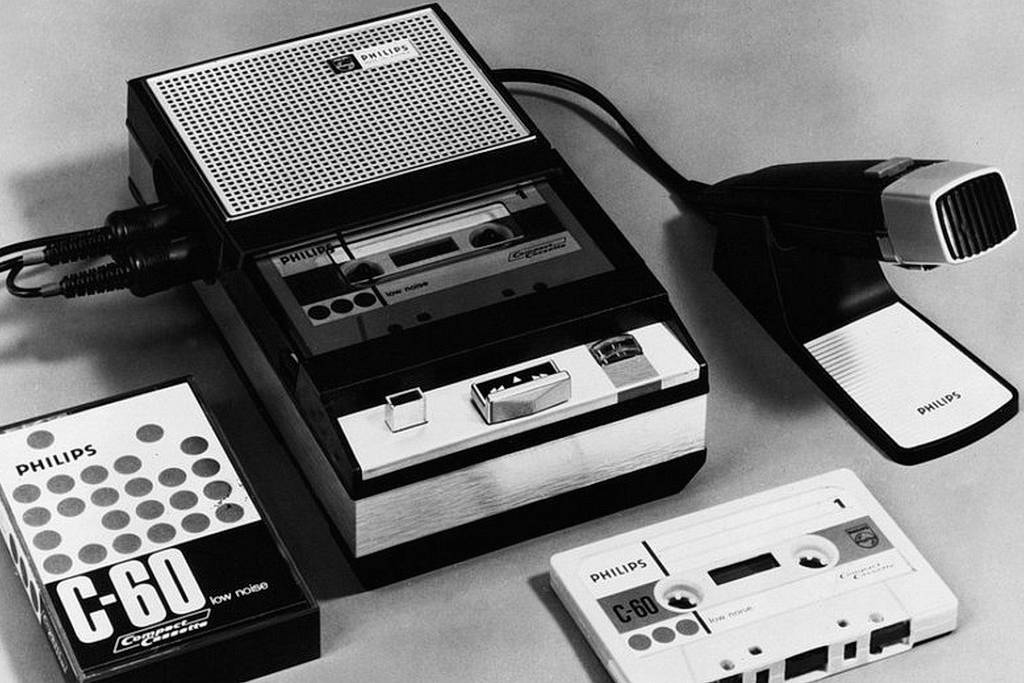
Lou Ottens (1926-06-21 – 2021-03-06) was born in Bellingwolde, in the south-east of the Netherlands, near the German border. During World War II, he constructed a radio with a primitive directional antenna to listen to Radio Oranje, a BBC European Service broadcast to the German-occupied Netherlands transmitted from London and lasting about 15 minutes.
Ottens attended Delft University of Technology. After he graduated from mechanical engineering studies in 1952, he was hired by Philips to work in the mechanization department of the Main Industry Group in Eindhoven. In 1957, he transferred to the Hasselt, Belgium, factory that produced audio equipment, such as turntables, tape recorders and loudspeakers.
Meanwhile, in 1958, on the other side of the world, RCA = Radio Corporation of America, proposed a worldwide tape recorder standard for a quick loading cartridge based on two flangeless hubs in a flat box. Flangeless hubs facilitate smaller dimensions because one reel diminishes as the other grows in diameter. It was based on the existing standard tape speed 3 ¾ IPS (inches per second) = 95 mm/sec and reversible utilisation for 2 x 30 minutes in stereo. Unfortunately for RCA, and fortunately for Philips, this proved to be an unsuitable solution. Quick rewinding and winding the tape could lead to jamming, and the power consumption due to the internal friction in the cartridge made it unsuitable for use in battery operated equipment.
In 1960, Ottens became the head of the new product development department and developed the EL 3585 portable tape recorder. One of its goals was to develop a pocket recorder, known today as a portable cassette recorder. It was to be inexpensive, physically small, with low battery consumption but with good, but not great, sound quality. Cassette design started with the cutting a block of wood that could fit into a jacket pocket. This developed into the EL 3300 cassette recorder. A team of ten/ twelve workers with design experience from gramophones and tape recorders were used to develop the cassette and its equipment.
The EL 3300 used a plastic enclosure 113 x 56 x 196 mm that held 5 x 1.5V batteries = 8.5 V power, but with the possibility of powering from the grid using a power jack. There were seven transistors (4 x AC125, 1 x AC126 and 2 x AC128) inside that provided 0.25 W of power to a permanent magnet dynamic loudspeaker with a moving coil) / Ø 2.4 inch = 61 mm.
The product was launched at the Internationale Funkausstellung Berlin = International radio exhibition Berlin = Berlin Radio Show, in 1963-08-30. This cassette was 1/4 the size of existing Fidelipac or Lear cartridges. It featured reversible housing with maximum tape protection allowing 30 or 45 minutes of stereo music per side. Tape speed: 47.6 mm/s. Tape width: 3.81 mm. In the US Philips used the name Norelco. A note for collectors: An original Philips EL3300 is not difficult to buy, but are in average (rather than pristine) condition. Prices vary, but are often US$ 50 to 60. Finding one requires patience.
Ottens made agreements with Sony for the patented Philips cassette mechanism to be a world standard. The triumph of the cassette tape ended only with the appearance of the Compact Disc format, another joint venture between Philips and Sony.
In 1969, Ottens became Director of Philips Hasselt, where it focused primarily on producing Philips cassette systems. Hasselts grew larger, with over 5000 employees.
In 1972 Ottens became director of audio at Philips’ NatLab, where he became involved in the next major music innovation: the CD. A collaboration was entered into with Sony and in 1980 the 120 mm Philips-Sony CD standard was ready for the world.
Ottens told the Dutch newspaper NRC Handelsblad, “Nothing can match the sound of the CD, It is absolutely noise and rumble-free. That never worked with tape … I have made a lot of record players and I know that the distortion with vinyl is much higher. I think people mainly hear what they want to hear.” Ottens had little patience with the renewed popularity of the cassette tape and vinyl. More than 100bn cassette tapes and 200bn CDs have been sold. When asked about his regrets, Ottens lamented that Sony had brought out the first Walkman.
Ottens retired from Philips in 1986. He became chairperson of the Dutch Association for Logistics Management in 1988. On 2021-03-06 Ottens died at his home in the village of Duizel in North Brabant, Netherlands.


Hi Brock
Hope you and family are keeping healthy and safe during these challenging times. I want to let you know how much I enjoy your blogs and am so impressed with the incredibly wide scope of knowledge you have and how brilliantly you share that. Take good care and hope life is returning to some sort of “normal” there.
Thanks, Darlene.
I only write for my friends. All of my “subscribers” are people I know from real life, even if it is many years since I have seen them. Subscriber is a fairly loose term, as I have added several people to the list. Anyone, of course, is free to unsubscribe if they find the topics uninteresting.
Best wishes,
Brock
Today, I have watched an interesting and well made YouTube video about Philips, The Death of Europe’s Last Electronic Giant. It was made by the German YouTuber known as TechAltar. It is enlightening to read many of the comments to the video. See: https://www.youtube.com/watch?v=WE58YisgFeQ